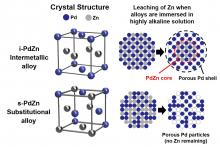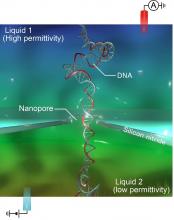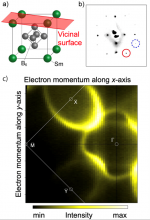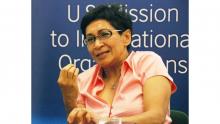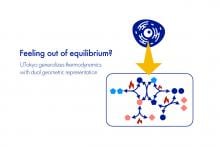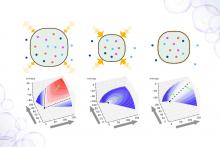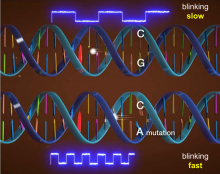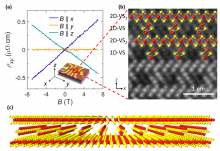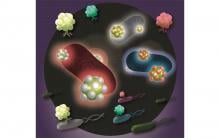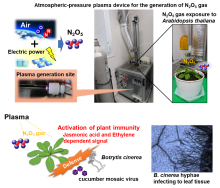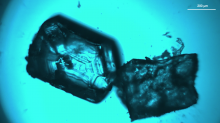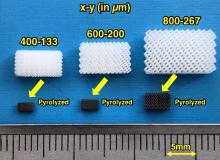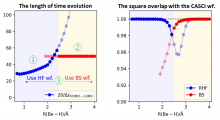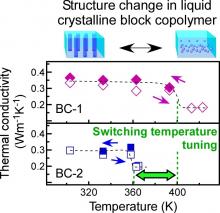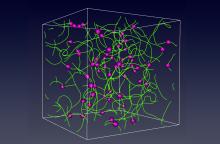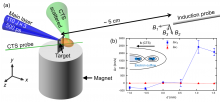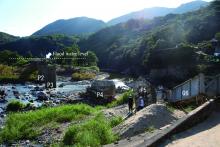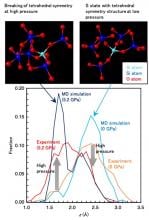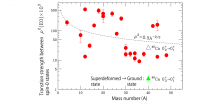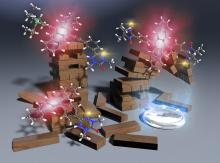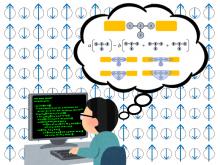Physics
News
18 Oct 2022
Osaka Metropolitan University researchers have created intermetallic alloy nanoparticles of palladium and zinc with an alternating arrangement of zinc and palladium atoms. The intermetallic alloy is more corrosion-resistant than substitutional alloys while retaining the electrocatalytic properties of both metals, which could be useful for developing new non-precious metal electrocatalysts.
05 Oct 2022
Researchers from Osaka University and collaborating partners enhanced DNA detection in silicon nitride nanopores by means of a water–glycerol viscosity gradient. Use of common chemistry under electrochemical flow enabled straightforward detection of individual DNA molecules. With further development, the results of this work could dramatically speed up and lower the cost of genomic sequencing, and facilitate unprecedented integration with compact electronics.
03 Oct 2022
Supermassive black holes can launch fast-moving plasma, which emit strong radio signals known as radio jets. Despite being discovered over 40 years ago, much remains unknown about how radio jets are produced. Now, a research team, led by Tohoku University astrophysicists, has attempted to clarify how plasma gets loaded into radio jets.
30 Sep 2022
Researchers from Osaka University revealed that the surface electronic structure of topological insulators varies according to its surface atomic structure, even though it was believed to have been protected by the symmetry of the electronic structure inside the crystal and is therefore unaffected by differences in surface atomic structure. This work offers a new means of minimizing the power consumption and increasing the speed of next-generation technology.
29 Sep 2022
Linked lanthanides shine light on crystal engineering, New technique reveals hidden genome, Red, white and blue alerts for dangerous bacteria & Windows gain competitive edge over global warming. Read all in the September's Editor's Choice plus this month's Asia Research News 2022 magazine pick - Floating sensors to gather ocean data.
21 Sep 2022
Giants in History: Malaysia’s first astrophysicist, Mazlan binti Othman (born 11 December 1951) was instrumental in launching the country’s first microsatellite, and in sending Malaysia’s first astronaut, Sheikh Muszaphar Shukor, into space.
16 Sep 2022
Scientists from The University of Tokyo formulated nonlinear, nonequilibrium energy dissipation relationships using methods from geometry to better understand the kinetics of irreversible chemical processes
12 Sep 2022
Researchers at The University of Tokyo create a geometric representation of thermodynamic systems and apply it to self-replicating processes, which may help improve our understanding of the physical constraints of living organisms
01 Sep 2022
Researchers from Osaka University and collaborating partners detected unique fluorescence blinking patterns in experiments of electron transfer to single DNA molecules. They used these patterns to identify mRNA glioma point mutations in cell culture. The results of this work could help simplify surgical biopsies, enable real-time targeted therapy, and advance scientific understanding of cancer progression.
31 Aug 2022
Researchers from Osaka University and collaborating partners used common nanofabrication procedures to fabricate versatile metal semiconductor superlattices. These superlattices exhibit a long-sought physical phenomenon—the anisotropic anomalous Hall effect at room temperature. This research will help improve the density of data storage, as well as the functionality of other technologies that also depend on advances in the microelectronics industry.
29 Aug 2022
Osaka Metropolitan University scientists developed a simple, rapid method for identifying food poisoning-inducing bacteria based on color differences in the scattered light of composite structures consisting of gold, silver, and copper nanoparticles and polymer particles. Using these composites as test labels bound to specific bacteria, the researchers detected food poisoning bacteria E. coli O26, E. coli O157, and S. aureus as white, red, and blue scattered light, respectively, under the microscope. This new method enables simultaneous identification of multiple bacterial species within one hour, significantly shortening the usual 48-hour time requirement for conventional bacterial tests.
29 Aug 2022
Tohoku University scientists in Japan have developed a mathematical description of what happens within tiny magnets as they fluctuate between states when an electric current and magnetic field are applied. Their findings, published in the journal Nature Communications, could act as the foundation for engineering more advanced computers that can quantify uncertainty while interpreting complex data.
19 Aug 2022
The flash of lightning and the dance of auroras contain a fourth state of matter known as plasma, which researchers have harnessed to produce a gas that may activate plant immunity against wide-spread diseases. The team, based at Tohoku University in Japan, published their findings on June 24 in PLOS One.
12 Aug 2022
Rare earth metals, when linked, can act as a conduit for energy flow, and show promise for the development of novel materials.
08 Aug 2022
Scientists from the Institute of Industrial Science, The University of Tokyo, demonstrate that accounting for liquid preordering is essential to predicting crystal growth
05 Aug 2022
New, easily fabricated, high performance carbon microlattice electrodes could soon be used to make cheaper batteries powered by readily available sodium ions. The approach was published by Tohoku University researchers and colleagues in the journal Small.
02 Aug 2022
Osaka Metropolitan University researchers have clarified the first suitable computational conditions for Adiabatic State Preparation (ASP) executable on a quantum computer, a method that can improve the accuracy of calculating atomic and molecular wave functions.
ASP is thought to be one of the leading methods for efficiently preparing correlated wave functions of molecules with complex electronic structures, but the specific conditions required for the calculations have not been thoroughly investigated so far. This new research has clarified the computational conditions needed to use ASP, a major development for making quantum chemical calculations on a quantum computer practical for chemical or materials research.
28 Jul 2022
Researchers from Osaka University and collaborating partners measured intracellular temperature gradients in human-derived cells at unprecedented spatial, temporal, and readout resolution. Intracellular temperature is a fundamental indicator of health, and corresponding gradients are the subject of medical hypotheses as well as potential drug development directions. The results of this work will advance such research by providing a versatile tool that's compatible with standard technology and procedures.
27 Jul 2022
Researchers from Osaka University and collaborating partners used straightforward chemical synthesis to modulate the phase transition of a thermal conductivity-switching block copolymer. Reversible changes in the nanostructured anisotropy in the material corresponded to an approximately two-fold change in the thermal conductivity, over the 27°C to 147°C temperature range. These results will enhance the sustainability of upcoming advanced flexible organic electronics.
06 Jul 2022
A research group of Professor Makoto Tsubota and Specially Appointed Assistant Professor Satoshi Yui, both from the Graduate School of Science and the Nambu Yoichiro Institute of Theoretical and Experimental Physics, Osaka Metropolitan University, in cooperation with their colleagues from Florida State University and Keio University, revealed that there are laws of vortex diffusion in superfluid helium-4 (He II) at extremely low temperatures, near absolute zero (−273°C). In this study, by conducting a systematic numerical study and comparing the results with experimental observations, the research group found that quantum vortices cause "superdiffusion" over short periods of time and "normal diffusion" over longer periods of time, similar to the movement of pollen in still water.
30 Jun 2022
Researchers at Kanazawa University report in The Journal of Physical Chemistry Letters how to simulate 3D atomic force microscopy images of out-of-equilibrium systems involving biomolecules. The approach makes use of a celebrated equation from thermodynamics applicable to non-equilibrium situations.
30 Jun 2022
A research team led by Osaka University realized magnetic reconnection driven by electron dynamics in laser-produced plasmas and measured the pure electron outflows. Their findings will be applied not only to space and astrophysical plasmas, but also to magnetic propulsion and fusion plasmas.
29 Jun 2022
Researchers analyze the collapse of the Misasa Railroad Bridge in Japan — an infrastructure failure caused by unprecedented flooding back in 2018 — to inform future flood-resistant designs.
27 Jun 2022
Understanding the structural origin of the anomalous properties of SiO2 liquid and glass is of great interest in a wide range of scientific fields. The fraction of the S state with tetrahedral symmetry structure is considered to be the controlling parameter of the anomalous properties of SiO2 liquid in theoretical studies. However, it has not been well identified in experiments. In this work, we find experimental evidence of tetrahedral symmetry breaking in SiO2 glass under pressure.
22 Jun 2022
An international team led by Osaka University used experimental measurements and theoretical modeling to better understand the shape formed by the protons and neutrons in the atomic nucleus of calcium-40. They found that destructive interference affects the mixture of elongated and spherical states. This research may help shed light on the reasons for the relative stability of atomic nuclei and how they are formed.
20 Jun 2022
Osaka Metropolitan University scientists detected, for the first time, collective resonance at remarkably high and broad frequency bands. In a magnetic superstructure called a chiral spin soliton lattice (CSL), they found that resonance could occur at such frequencies with small changes in magnetic field strength. The findings suggest CSL-hosting chiral helimagnets as promising materials for future communication technologies.
17 Jun 2022
A research group led by Professor Yoshio Teki of the Osaka Metropolitan University Graduate School of Engineering has succeeded in developing a new pentacene derivative that is more than 100 times more photostable than TIPS-pentacene, a photostable pentacene derivative. Additionally, the team has further clarified the ultrafast excited state dynamics in this system. In the pentacene moiety of this system, we were able to demonstrate that the transition from the excited singlet state to the excited triplet state occurs ultrafast in the time region of a 10-13 seconds. In purely organic materials without heavy atoms such as rare metals, such intersystem crossing usually occurs on time scales longer than 10-9 seconds. The empirical results of this study are expected to be applied as a method for stabilizing and developing light-unstable materials in the future.
09 Jun 2022
Giants in History: Hideki Yukawa (23 January 1907 – 8 September 1981) was awarded the Nobel Prize in Physics in 1949 for predicting the existence of the pi meson subatomic particle
06 Jun 2022
Researchers at the Institute of Industrial Science, The University of Tokyo studied the anomalous properties of amorphous solids, including glasses, using computer simulations, and found a common vibrational mechanism underlying them, which may help control the glass properties
30 May 2022
Dr. Nishikawa at Osaka Metropolitan University focused on the Kondo effect on minimal ferrimagnetism and attempted to elucidate it theoretically. As a result, they found that the Kondo effect occurred via multiple "quantum entangled states" depending on temperature and other factors. They also found that the Kondo effect suppressed electrical conductivity through minimal ferrimagnetism, when usually it is amplified in many other cases.
Events
Sorry, nothing coming up for this discipline
Researchers
Sorry, nothing coming up for this discipline
Giants in history
Sorry, nothing coming up for this discipline


